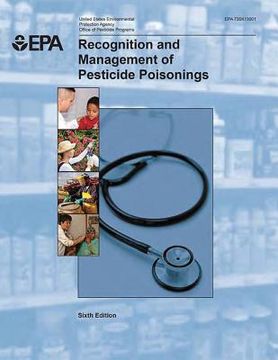Share
Recognition and Management of Pesticide Poisonings (in English)
Agency, U. S. Environmental Protection (Author)
·
Createspace Independent Publishing Platform
· Paperback
Recognition and Management of Pesticide Poisonings (in English) - Agency, U. S. Environmental Protection
$ 15.99
$ 19.99
You save: $ 4.00
Choose the list to add your product or create one New List
✓ Product added successfully to the Wishlist.
Go to My WishlistsIt will be shipped from our warehouse between
Tuesday, July 09 and
Wednesday, July 10.
You will receive it anywhere in United States between 1 and 3 business days after shipment.
Synopsis "Recognition and Management of Pesticide Poisonings (in English)"
The purpose of this manual is to provide healthcare professionals with current consensus recommendations for treating patients with pesticide-related illnesses or injuries. The Office of Pesticide Programs of the U.S. Environmental Protection Agency has sponsored the series since 1973. The 5th edition of this manual was published in 1999; since then, much has changed with regard to the pesticide products on the market. Most indoor uses of organophosphates have been eliminated, and a combination of EPA risk mitigation actions has limited their use on food crops. Pyrethroids have largely replaced organophosphates for residential pest control. While this conversion is beneficial in that the risk to human health is lower with this relatively less acutely toxic class of pesticide, it introduces a new set of health issues for consideration. Many new pesticide products have been registered and are not necessarily widely known among health professionals. This 6th edition includes a chapter that explores potential association between low-level exposure to pesticides over time and chronic diseases. There is general agreement that prevention of pesticide poisoning remains a much surer path to safety and health than reliance on treatment. In addition to the inherent toxicity of pesticides, none of the medical procedures or drugs used in treating poisonings is risk free. In fact, many antidotes are toxic in their own right, and such apparently simple procedures as gastric intubation involve substantial risk. The clinician must weigh the hazards of various courses of action (including no treatment at all) against the risks of various interventions, such as gastric emptying, catharsis, administration of intravenous fluids or administration of an antidote, if available. Clinical management decisions have to be made promptly and, as often as not, on the basis of limited scientific and medical information. The complex circumstances of human poisonings rarely allow for precise comparisons of alternative management strategies. Therefore, it is important for the reader to keep in mind that the treatment recommendations in this book do not guarantee successful outcomes. They are merely consensus judgments of the best available clinical management options. Clinical toxicology is a dynamic field of medicine; new treatment methods are developed regularly, and the effectiveness of old as well as new modalities is subject to constant critical review.
- 0% (0)
- 0% (0)
- 0% (0)
- 0% (0)
- 0% (0)
All books in our catalog are Original.
The book is written in English.
The binding of this edition is Paperback.
✓ Producto agregado correctamente al carro, Ir a Pagar.

